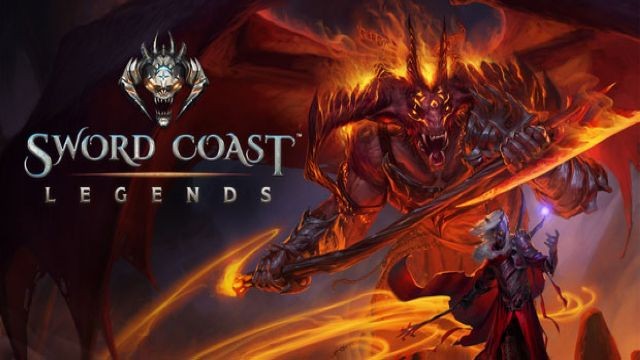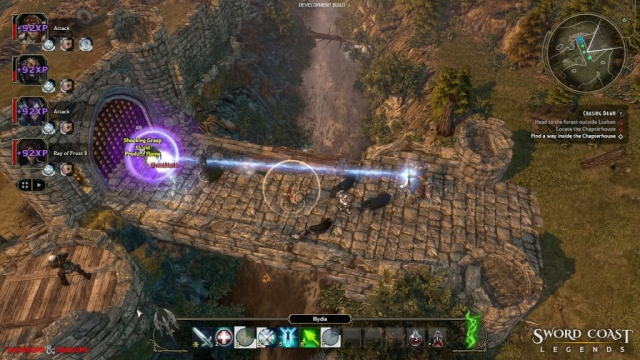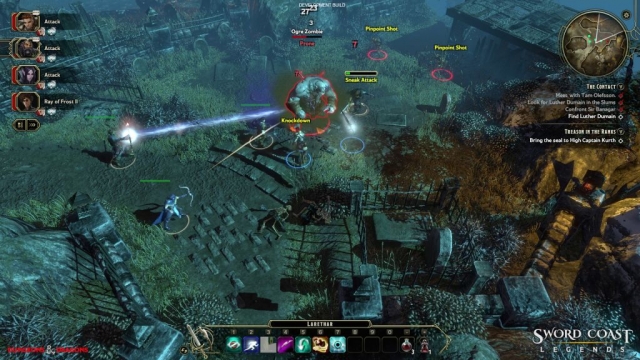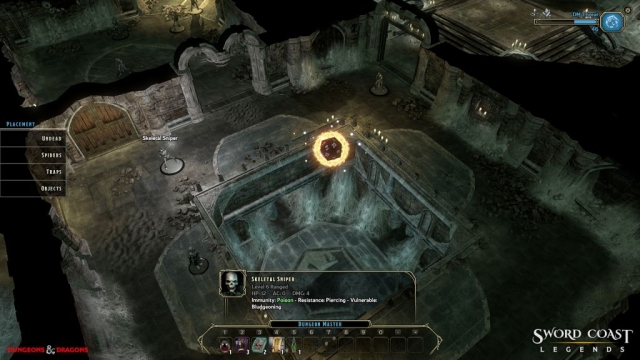Sword Coast Legends

The Good: Stunning scenery. Outstanding voice work and music. Great dialog. Interesting multiplayer.
The Bad: Overly fussy, overly scripted single player adventure. Fetch quests like it’s 1999!
The Ugly: Combat control scheme kind of a mess.
For your information, or more likely for the information of the companies that make these games, I rarely spend a lot of time looking at marketing materials. Companies create all kinds of stuff – videos, artwork packs, designer interviews – and send me links to YouTube and ftp sites, but I’m going to judge a game based on how it plays, not on what the designer says about what he was thinking when he made it. Sword Coast Legends however sent along YouTube links to videos about dungeon creation using the in-game dungeon master interface, and though I didn’t watch the whole thing (several are about an hour long), I did watch a fair amount, and found myself thinking “These guys gets it.” These were guys who had played, as I had, pencil and graph paper D&D, and had really thought about how dungeon creation works, the pacing and balance of adventuring, and combat and treasure and gaining experience.
For the first several hours, five or six maybe, I felt that, the care they took in setting up their world. The voice work was among the best I’ve ever experienced, the music fit the gameplay to a T, and the scenery was intricate and beautiful. Torches smoked, dungeons were dank and creepy. It was couple of hours later that the warts really started to show, the elements that by hour 10 or so were well on their way to driving me more than a little nuts. You want some examples? Oh, baby, have I got examples.
So I’ve got a piece of coal. I’m not sure where I got it exactly. I had picked it up in some dungeon crawl along with a pair of dirty socks and a beer tankard and a bag of chalk (all real in-game items). I had sold the socks and tankard and chalk when encumbrance became a problem, but had held onto the coal. It didn’t weigh much, and my D&D brain told me that it could perhaps be a spell component. Then later, I had a woman ask me for a piece of coal to treat her sister’s poisoning, and I thought, aha! I’ve got one of those! What a wild stroke of luck! Except that she won’t accept it. The game dialog provides no way for me to give it to her. She directs me to look in the fireplaces in the house to find coal. I find some in the kitchen, and when I go back she won’t take that piece of coal because the cook spilled fish soup on it. I’ve got to find a piece of coal from a different fireplace. The piece of coal I’ve already got is worthless, just so much dungeon flotsam. And the game is rife with this kind of overly specific fetch quest. I’ve got to find some grave dust in a cemetery, which you think would be pretty easy with all the graves around, except I’ve got to locate and dig up the specific grave the game is thinking of. I search and clear dungeons in random wanderings, but then am sent back to that same dungeon to kill some creature or collect some artifact that only appears after I got the quest. The scripting that supports the quest system is inflexible, and it makes solving the numerous fetch quests a step-by-step activity that is really onerous.
The control scheme, at least for the single player game, borders on unworkable. Trying to ride the razor’s edge between Diablo-style action and NWN tactics, it succeeds in neither. Character creation is a pretty advanced affair (as I would hope D&D character creation would be), allowing you to allocate points to state and abilities (along with the usual nose width and lip fullness), but especially at higher levels you’ll find yourself with so many abilities they hardly fit on the hotkey bar. When rolling along in real time (with no control for slowing it down), trying to make combat decisions, run all these different hotkeys, for four characters is simply impossible. If you choose to control just one character, the others run along on autopilot. There are some things the autopilot is good at (basic attack and spell use), and things it is bad at (using consumables such as scrolls or potions, systematically whittling down enemy forces, and generally self preservation). Still, this is the way I played it for the most part and you can get through the single player adventure this way. The alternative is to pause (using the space bar), issue commands to everyone, and start it up again, then hit the space bar again at the conclusion of those actions. In real time combat this results in, as I’m sure you can imagine, spastic space bar mashing and a lack of any sort of combat flow.
In multiplayer, at least the control problem goes away. I think in some ways this was a game meant for multiplayer, an attempt at recreating Saturday afternoon pencil and graph paper D&D adventuring online. Joined by three friends, you can go through the adventure and only worry about controlling your character, for which the interface is OK. Even better (I think, I never actually got this feature to work for me), you can play dungeon master to a group of friends (or more likely online strangers through their lobby). You can create an entire world full of quests and cities and NPCs. I started playing with this function, found that the generation system works pretty well, but only to most devoted lunatics with acres of spare time on their hands are going to create entire modules. A more bit size approach, and I think the one most will take, is to create a single dungeon and let players crawl through that.
The dungeon engine is both expansive and pretty limiting. The room layout is random, so that plan of mine to make a sort of downward spiral map, something with a pit of hell motif, I don’t think is possible. A random layout of rooms is all you can get. You can stock these with monsters, but the more advanced functions – ambushes, doors operated by pressure plates and such – appear to be only available to the engine which throw a few in when it randomizes the dungeon. You also can’t seem to set the contents of treasure chests – the game generates those when you place them. I suppose this keeps you from creating a dungeon that gives out a bazillion gold pieces to first level characters and breaks the world economy, because any character you take into the multiplayer world you can take back into the single player game with whatever they picked up.
Anyway, once you’ve set up your dungeon, which is both pretty enjoyable and an incredibly time consuming activity, you, uh, I don’t know. Despite watching (or rather skipping around in) several one hour videos, and going online to read the wiki (which today is largely blank), and spending a couple of hours randomly clicking buttons to see what I could get to happen, I couldn’t seem to figure out how to invite people to play my dungeon (or maybe they were successfully invited, and chose not to, and I have no friends). But as evidenced by the lobby in which there are people running custom dungeons, some people have figured it out where I have failed. There is an active point system in which the dungeon master is given activity points (for some vague reason they’re called “threat”) to tweak the dungeon in real time that tries to encourage them to strike a balance between challenging their players and simply executing them. The dozen or so DM’ed dungeons I played online showed this system somewhat effective, though a couple of maps definitely were mastered by sadistic trolls. On top of this is a passive point system in which players can rate the DM after the map is over (provided they survive to do so), so maybe over time the trolls will find their way to the bottom of the ratings. Fortunately at least, characters killed online are not permadeathed. Oh, and one more note on multiplayer that just about everyone online is complaining about – the treasure in the maps is singular, meaning if one player empties out a chest, the next player finds it empty, and one greedy snot can hoover up most of the loot if they’re fast. I repeatedly heard DMs (using mikes) tell players to try and spread the treasure around.
In some sense, though Sword Coast Legends is no Baldur’s Gate or NWN or Icewind Dale, I appreciate what they’ve tried to do here, even if the outcome could use some help. To their credit, they say in interviews they’re going to stick with it and try and fix issues as they hear about them. Some of them, like the treasure issue in multiplayer, are very easy to fix. Others, like the single player interface, are tougher, maybe impossible. And as the wiki fills in, and I can figure out how to create some dungeons and get them in play, maybe you’ll see me up there someday. I promise not to roast your carcasses over a slow spit unnecessarily.
Reviewed By: Phil Soletsky
Publisher: Digital Extremes
Rating: 65%
——————————————————————————–
This review is based on a digital copy of Sword Coast Legends for the PC provided by Digital Extremes.
 Game Over Online
Game Over Online













